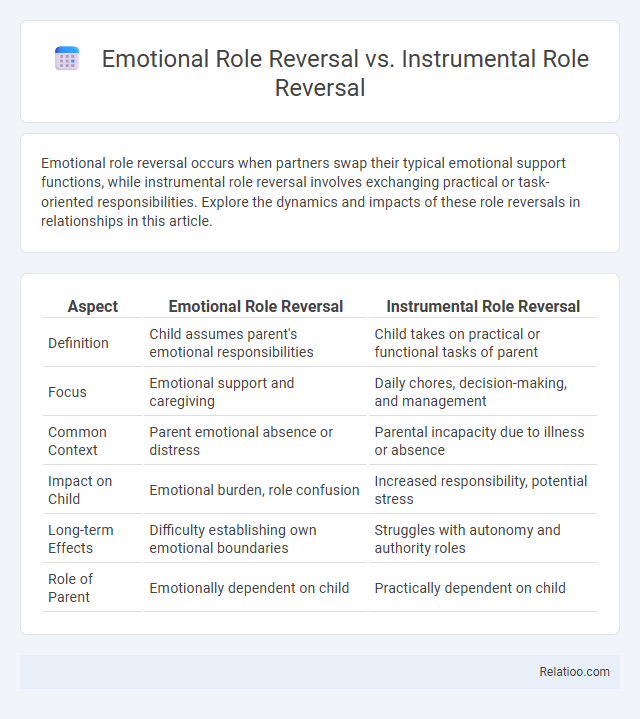Emotional role reversal occurs when partners swap their typical emotional support functions, while instrumental role reversal involves exchanging practical or task-oriented responsibilities. Explore the dynamics and impacts of these role reversals in relationships in this article.
Table of Comparison
| Aspect | Emotional Role Reversal | Instrumental Role Reversal |
|---|---|---|
| Definition | Child assumes parent's emotional responsibilities | Child takes on practical or functional tasks of parent |
| Focus | Emotional support and caregiving | Daily chores, decision-making, and management |
| Common Context | Parent emotional absence or distress | Parental incapacity due to illness or absence |
| Impact on Child | Emotional burden, role confusion | Increased responsibility, potential stress |
| Long-term Effects | Difficulty establishing own emotional boundaries | Struggles with autonomy and authority roles |
| Role of Parent | Emotionally dependent on child | Practically dependent on child |
Understanding Role Reversal: Emotional vs. Instrumental
Understanding role reversal involves distinguishing emotional role reversal, where individuals take on each other's feelings and emotional burdens, from instrumental role reversal, which centers on swapping practical tasks or responsibilities. Emotional role reversal deeply impacts interpersonal dynamics by blurring boundaries and fostering empathy or enmeshment, while instrumental role reversal shifts functional roles in relationships without necessarily affecting emotional connections. Recognizing these differences aids in addressing relationship challenges and improving communication by clarifying whether emotional or task-based exchanges are occurring.
Defining Emotional Role Reversal
Emotional Role Reversal occurs when a child assumes the emotional responsibilities typically held by a parent, providing support or comfort in place of receiving it, which contrasts with Instrumental Role Reversal where the child takes on practical caregiving tasks such as household management. Role Reversal broadly refers to any scenario where traditional roles within a relationship or family system are inverted, but the emotional aspect specifically characterizes Emotional Role Reversal. This dynamic often leads to blurred boundaries and can impact the child's emotional development and identity formation.
What is Instrumental Role Reversal?
Instrumental Role Reversal involves swapping practical or task-oriented responsibilities between individuals, emphasizing actions over emotions or feelings. Unlike Emotional Role Reversal, which centers on experiencing or acknowledging the other's emotions, Instrumental Role Reversal focuses on understanding and executing specific duties or tasks from the other person's perspective. When you engage in Instrumental Role Reversal, you gain insight into the challenges and skills required in another's role, enhancing empathy and collaboration.
Key Differences between Emotional and Instrumental Role Reversal
Emotional Role Reversal occurs when individuals or caregivers take on the emotional responsibilities typically held by the other party, leading to blurred boundaries and potential enmeshment. Instrumental Role Reversal involves the swapping of practical or task-oriented responsibilities, such as a child performing caregiving duties for a parent, without necessarily affecting emotional dynamics. The key difference lies in Emotional Role Reversal impacting affective support and emotional regulation, whereas Instrumental Role Reversal primarily alters functional roles and daily task management.
Causes of Emotional Role Reversal in Relationships
Emotional role reversal in relationships often stems from unresolved trauma, codependency, or unmet emotional needs, causing one partner to assume the emotional caretaker role typically held by the other. Unlike instrumental role reversal, which involves switching practical responsibilities like finances or household tasks, emotional role reversal centers on shifts in emotional support and caregiving dynamics. Understanding these causes is critical for therapists aiming to restore healthy boundaries and balance in couples therapy.
Triggers for Instrumental Role Reversal
Instrumental Role Reversal is typically triggered by situational demands requiring a shift in task-oriented responsibilities, often arising during caregiver strain or sudden changes in a relationship's functional dynamics. Emotional Role Reversal, in contrast, stems from unmet emotional needs or psychological stress, leading individuals to assume nurturing roles beyond their typical boundaries. General Role Reversal encompasses both emotional and instrumental shifts but lacks the specific catalyst of functional necessity that characterizes Instrumental Role Reversal triggers.
Psychological Impact of Emotional Role Reversal
Emotional Role Reversal involves one partner assuming the emotional responsibilities typically managed by the other, often leading to stress, anxiety, and burnout due to unbalanced emotional labor. In contrast, Instrumental Role Reversal refers to switching practical or task-oriented duties without the same emotional burden, thus having less psychological impact. Role Reversal broadly encompasses both types, but the psychological strain is most pronounced in Emotional Role Reversal due to the heightened vulnerability and potential for emotional exhaustion.
Effects of Instrumental Role Reversal on Family Dynamics
Instrumental role reversal occurs when children assume caregiving or decision-making responsibilities typically held by parents, disrupting traditional family hierarchies and leading to increased stress and role confusion. This shift often results in emotional strain, as parents may feel undermined or helpless, while children experience premature maturity and anxiety. Long-term effects include impaired boundary setting and altered attachment patterns, impacting family cohesion and individual emotional well-being.
Addressing and Managing Role Reversals
Addressing role reversals requires recognizing the differences between emotional role reversal, where emotional support responsibilities shift unexpectedly, and instrumental role reversal, involving changes in practical tasks or caregiving duties. Managing Your role reversals effectively involves setting clear boundaries, open communication, and seeking external support when necessary to maintain balance in relationships. Tailoring intervention strategies to the specific type of role reversal promotes healthier dynamics and reduces stress for all involved.
Promoting Healthy Boundaries in Role Reversals
Role reversal in relationships involves shifts in roles where emotional or instrumental dynamics are exchanged. Emotional role reversal occurs when a child or dependent assumes caregiving responsibilities typically held by a parent, potentially blurring boundaries and impacting emotional development. Instrumental role reversal involves practical task shifts without emotional crossing, making it easier to maintain healthy boundaries and prevent enmeshment or role confusion.

Infographic: Emotional Role Reversal vs Instrumental Role Reversal
 relatioo.com
relatioo.com